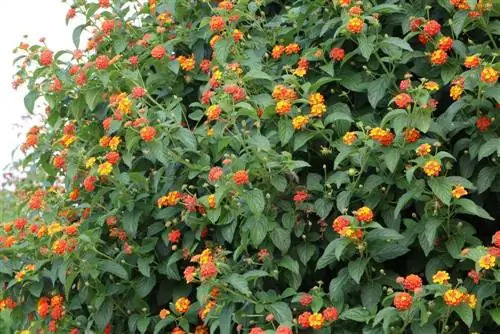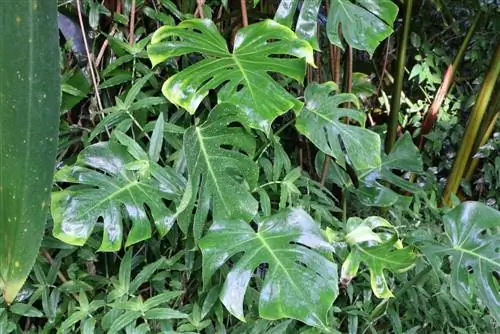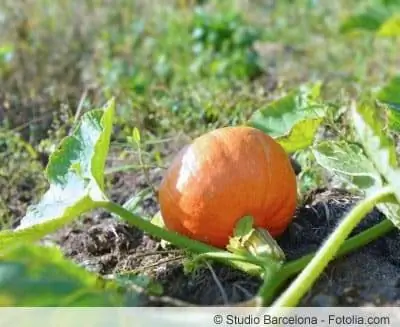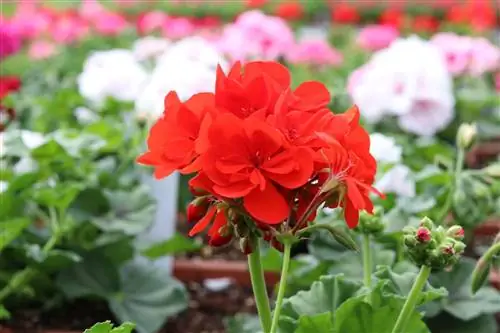- Author admin [email protected].
- Public 2023-12-17 03:39.
- Last modified 2025-01-24 12:45.
The lantana, which comes from America and from the verbena family, is one of the most popular ornamental plants in Western Europe. Especially in pots and containers as a standard, tendril and hanging plant, it tastefully decorates summer terraces and balconies with its colorful flowers. A sea of flowers from lantana can be easily created through propagation. The expert instructions show you how to do it step by step.
Propagation
Although lantanas are very easy to care for and undemanding, they are cultivated in poor soil and small pots, often with growth inhibition and a lack of robustness. This is usually the case with the cheapest potted plants. In order to enjoy this ornamental flower for years to come, it is worth propagating it, which can be done in various ways. You also don't have to spend unnecessary money buying new flowers every year, because here too, propagation will always increase your lantana population.
By propagating, you grow a new specimen from an existing plant, which, under optimal conditions, thrives in fast, densely growing florets and impresses with its many flowers and intense colors. The most promising types of propagation include self-harvested seeds and cuttings.
Seeds
Seeds are mainly available packaged in bags over the Internet, but these are usually exotic products from tropical countries. When using these, you have to be very careful, as the seeds come from different weather conditions and these or the resulting new plants could have problems with the European climate. In the long term, propagation through seeds is more likely to be successful if they are collected and used from European breeding species.
To do this, simply buy a lantana, pot it in a high-quality substrate with a high nutrient content and keep it evenly moist. In midsummer, small berries should form in which the seeds can be found. However, the seeds are only ready to harvest when the berries are black at the end of summer. You should then store the seeds until the optimal sowing date.
Seed storage
So that you can grow new plants from lantana seeds, it is essential that you adhere to a few storage conditions:
- Cut open berries and remove seeds before storage
- Lay out evenly on newspaper or kitchen roll to dry
- After about four to five days, store in paper bags - do not use a plastic bag!
- Store seeds in a dry and dark place until next spring
- Optimal storage temperature around 15 degrees Celsius
- Sowing
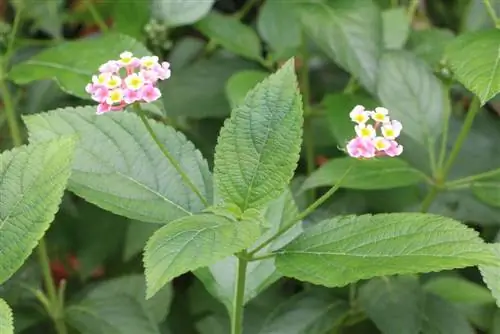
Since the seeds take a few weeks to germinate, it is recommended to start sowing around four weeks before the first frost or before the ice saints. The start of sowing is then done inside the house at warm temperatures. Proceed as follows:
- Fill the growing box or suitable top with growing soil
- Use your fingers to lightly press the substrate lengthwise in the propagation box or in the middle of the pot
- Distribute seeds evenly
- Around three seeds are calculated per centimeter
- Cover the seed about two millimeters with substrate/growing soil, but do not press it down
- Put transparent plastic film over the sowing
- Location: bright with direct sunlight
- Temperature: between 22 degrees Celsius and 28 degrees Celsius
- Germination: around three or four weeks
- Pricking: at the latest when the size is five centimeters
- When the outside temperature is at least 18 degrees Celsius, pricked new plants can go outside
Cuttings
An older plant is best suited for propagation through cuttings. The optimal time for this type of propagation is spring from the end of May to mid-June. If you cut cuttings later, you run the risk of them not being strong enough to survive the cold season unscathed. Although they will not necessarily die, they will usually react the following year with a lack of growth and the first flowers will take longer to appear.
With the following step-by-step instructions, propagation of cuttings almost always works:
Preparation
- Look for only annual shoots with at least two buds
- Shoots must be between ten and twelve centimeters long
- Separate shoots below the last pair of leaves from the main stem
- Only use sharp knives or scissors for cutting
- Cut off the bottom two pairs of leaves so that only four to six leaves remain
- Remove cuttings from inflorescences and shorten shoot tips
Tip:
On the mother plant you should use charcoal powder to cover the cuts. This serves to dry them quickly and at the same time prevents bacteria from getting inside that can cause illness.
Planting
- Fill the pot with nutrient-poor but humus-rich substrate
- Press substrate moderately
- Place the cutting into the substrate up to about two centimeters below the first pair of leaves
- Spread some substrate around the stem and press firmly for more hold
- Spray substrate with plenty of water or water carefully
- Cover the cutting with transparent plastic film
- Location: bright - no direct sun
- Temperature: room temperature, but no direct heating air
- Root formation: after around two weeks
- Get used to any temperature differences by hardening off before putting it out in spring
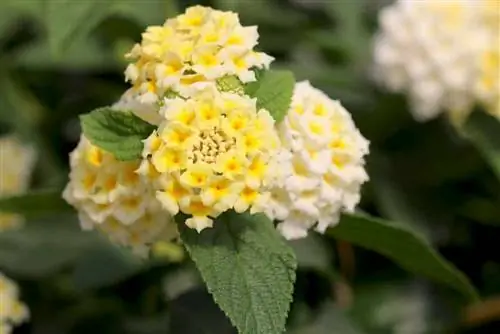
As an alternative to planting, roots can also be created by placing them in a glass of water. To do this, ideally use a dark glass and fill it with lime-free (rain) water, which you have to change at least every two days. Then place the cutting in the water glass. Once some strong roots have formed, you can plant the cutting. As a rule, rooting here also takes around two weeks.
Tip:
If the cutting stem is still soft, the hole should be pierced with a pricking knife. In this way, you prevent the stem structure from tearing when the cutting is inserted.
Hardening
In order to get the young plants used to cooler or fluctuating outside temperatures, they should be introduced slowly. This is necessary because the small lantanas are still quite vulnerable in their first and second year. Hardening them off strengthens them and allows them to stay outside in the first year, even in cooler night temperatures.
To harden them off, place them in their pot on the patio or balcony during the day. At first it was supposed to be a pure sunny spot. When the sun is gone, the young plant is brought back into the house. From the second week onwards it can also tolerate a place where the sun is replaced by shade. In the cooler evenings, she will continue to be brought in.
From the fourth week onwards, the newly grown lantana can stay outside all day, regardless of wind and weather. At night, for example, it should be placed in the garage or basement, where it is cooler than in the living room. By the sixth week it should be hardy enough to be able to stay outside around the clock.
Floor
Whether planted in the garden bed or in a pot, the young lantana plants need optimal soil from the first year onwards in order to be able to grow strong and he althy. The floor should meet the following requirements:
- Compost-based nutrient-rich soil
- Permeable
- limestone
- pH value: neutral to acidic
Pouring

In the first few weeks, the young plant should ideally only be moistened with a sprayer. Irrigation water from a watering can can quickly wash the loose soil away from the stem if the stream is too hard, thus depriving the young plant of its support in the ground. Moistening by spraying is more advantageous here, although less water should not be used. Even as young plants, lantana always needs well-moist soil from spring to the end of summer. In winter the water requirement decreases, but the soil must not dry out.
Always use lime-free water, such as rainwater. Alternatively, you can also use tap water after it has been allowed to sit for around two days. The lime then settles on the walls and bottom of the container and there is little to no lime left in the irrigation water.
Fertilize
This rose plant is not fertilized in the first year. Here it is still sufficiently supplied by nutrient-rich soil. If it has become stronger in the second year, the nutrient requirements increase and it should be fertilized as follows:
- Fertilize every four weeks at the beginning of the growth phase in May
- Fertilize every two weeks from bud formation
- Fertilize every six weeks between September and April
- Use normal liquid fertilizer or organic natural fertilizer
- Strictly adhere to the manufacturer's dosage instructions!
Cutting
Before autumn, the newly grown lantana should be cut for the first time. To do this, shorten the stems evenly by a maximum of a third in length. In the second spring, before sprouting, you can shorten the stems again by around three centimeters and, above all, remove the withered flowers and leaves, but then cut less towards autumn.
From the third year onwards, it is recommended to shorten it to around ten centimeters before the first shoots can be seen. In this way, the lantana grows densely, stretches out and develops into a strong plant.
Wintering
The lantana needs hibernation between October and March. This occurs at temperatures between five degrees Celsius and ten degrees Celsius. Only in this coolness can the metabolism slow down and rest. If it is too warm, the leaves can fall off and react with little to no flowers and low growth, especially next year.

From around the end of February, when the first early spring flowers appear, the young plant should be kept warmer so that the metabolism slowly gets back into gear and the budding is stimulated, which takes a few weeks.
Conclusion
The Lantana conjures up summery freshness in gardens and on balconies thanks to its intense colors and play of colors. Not only is it very easy to care for, but it is also easy to propagate and create large flower beds. Propagation does not require any special gardening expertise, but can be easily carried out by any layperson with these professional instructions. The only thing you need is optimal soil, the right sunny location and a little patience and attention so that the newly grown lantana doesn't dry out. Propagation through seeds and cuttings offers an optimal opportunity to decorate balconies, terraces and flower beds with a summery flair, free of charge.

